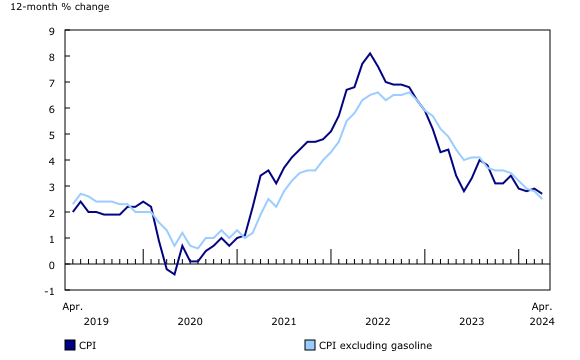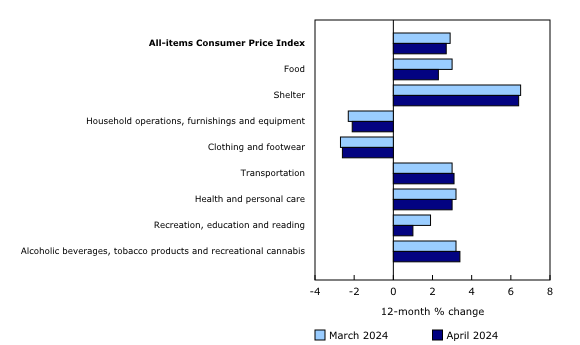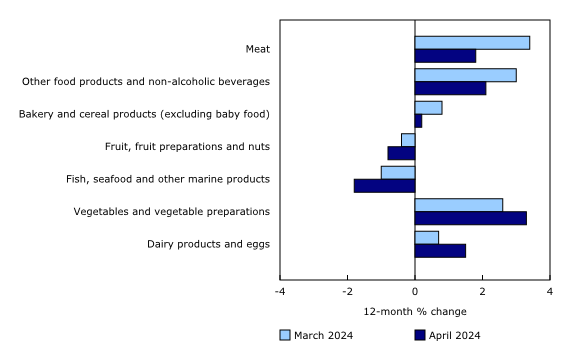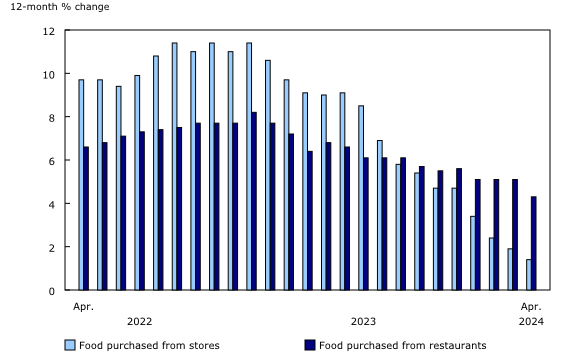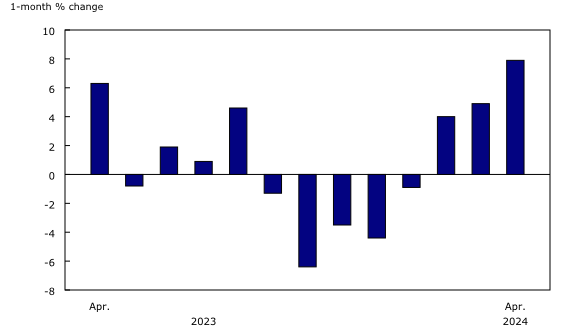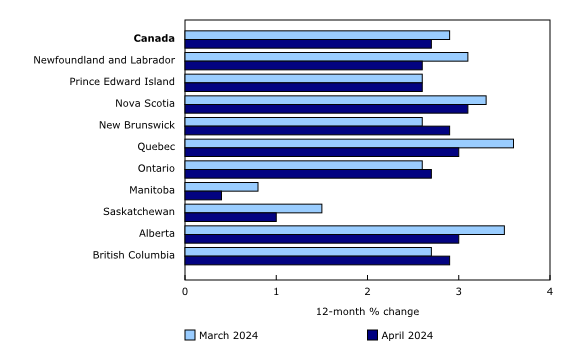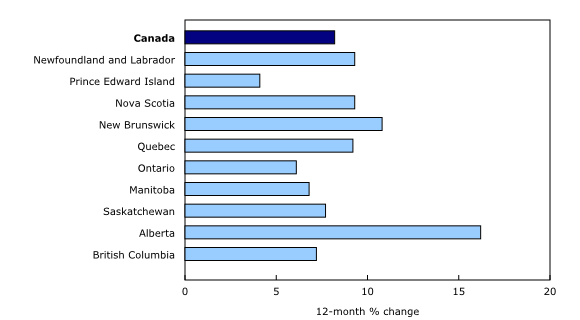Consumer Price Index, April 2024
Released: 2024-05-21
The Consumer Price Index (CPI) rose 2.7% on a year-over-year basis in April, down from a 2.9% gain in March. Broad-based deceleration in the headline CPI was led by food prices, services and durable goods.
The deceleration in the CPI was moderated by gasoline prices, which rose at a faster pace in April (+6.1%) than in March (+4.5%). Excluding gasoline, the all-items CPI slowed to a 2.5% year-over-year increase, down from a 2.8% gain in March.
On a monthly basis, the CPI rose 0.5% in April, mainly driven by prices for gasoline. On a seasonally adjusted monthly basis, the CPI rose 0.2% in April.
Food prices lead the deceleration in the Consumer Price Index
While prices for food purchased from stores continue to increase, the index grew at a slower pace year over year in April (+1.4%) compared with March (+1.9%). Meat contributed the most to slower price growth, largely due to a base-year effect in prices for fresh or frozen beef (+4.4%) as a result of a monthly increase in April 2023 which fell out of the 12-month movement. Other contributors to the slowdown in grocery prices included other food products and non-alcoholic beverages (+2.1%), bakery and cereal products (+0.2%), fruit, fruit preparations and nuts (-0.8%) and fish, seafood and other marine products (-1.8%). From April 2021 to April 2024, prices for food purchased from stores increased 21.4%.
Price growth for food purchased from restaurants also eased on a yearly basis, rising 4.3% in April 2024 following a 5.1% increase in March. The index was unchanged month over month in April, however a 0.8% monthly increase from April 2023 fell out of the 12-month movement and put downward pressure on the index.
Did you know Statistics Canada uses the most robust food data available for the Consumer Price Index?
Food is the second-largest major Consumer Price Index (CPI) component. Based on 2022 expenditures, Canadians directed 16.65% of their household budget to food purchases, with food purchased from stores accounting for 11.04% of household budgets. Reflecting this importance, food price data undergoes a rigorous review process. Statistics Canada works with price experts and other national statistical organizations to ensure that the methods used to calculate the CPI are aligned with international standards and best practices.
Grocery prices are mostly captured using scanner data, also known as point-of-sale data, received directly from grocery retailers. Scanner data are the highest quality price data available and the gold standard for price collection. They track actual prices paid by Canadians at the till, including sales, promotions and quantity details. Grocery prices are also collected using websites or flyers where scanner data are not available. Food price data in the CPI cover every province and every territorial capital and are collected from nearly 500 grocery retailer outlets. This makes the food price data used in the CPI the most robust in the nation.
The CPI measures pure price change based on a fixed basket of goods and services. The same products are priced at the same outlets every month and undergo quantity and quality adjustments. For instance, if a product's size is reduced but the price remains the same, often referred to as shrinkflation, it is treated as a price increase as the consumer gets less for the same price.
Average prices versus the Consumer Price Index
Using only scanner data, Statistics Canada produces the Monthly average retail prices for selected products (18-10-0245-01). The table shows the average price Canadians paid for selected products in a given month, providing additional context to food prices, by product and region. However, users should exercise caution when comparing average prices over time as they may not be fully comparable from one month to another due to product rotation, availability, and fluctuating purchase compositions (weights, stores, and brands). Rather, it is the CPI that should be used to compare prices over time, as it measures pure price change across the grocery landscape.
Food price data and analysis is featured on our Food Price Data Hub. Newly released analytical products such as "From Shelf to Statistic: An Overview of Food Price Measurement in the Consumer Price Index" and "Why Food Inflation Is Such A Hard Nut To Crack," a new Eh Sayers podcast, are now available.
Gasoline prices moderate deceleration in the Consumer Price Index
Consumers paid 6.1% more at the pump year over year in April, following a 4.5% increase in March. Faster growth was driven by a 7.9% month-over-month increase in April. Higher costs associated with switching to summer blends, higher oil prices due to supply concerns and an increase in the federal carbon levy all contributed to the increase in prices.
Explore the Consumer Price Index tools
Check out the Personal Inflation Calculator. This interactive calculator allows you to enter dollar amounts in the common expense categories to produce a personalized inflation rate, which you can compare to the official measure of inflation for the average Canadian household—the Consumer Price Index (CPI).
Browse the Consumer Price Index Data Visualization Tool to access current (Latest Snapshot of the CPI) and historical (Price trends: 1914 to today) CPI data in a customizable visual format.
Regional highlights
Year over year, prices rose at a slower pace in April compared with March in six provinces.
Alberta inflation slows, but shows largest rent increases in Canada
The CPI in Alberta decelerated year over year in April partly due to prices for electricity and natural gas. Partially offsetting this were higher prices for rent, which rose 16.2% year over year in April, up from a 14.2% increase in March. Rent in Alberta increased at a higher rate than it did at the national level (+8.2% in April) for the eighth consecutive month, which coincides with strong demand from high net interprovincial migration to Alberta.
Did you know we have a mobile app?
Download our mobile app and get timely access to data at your fingertips! The StatsCAN app is available for free on the App Store and on Google Play.
Note to readers
Visit the Consumer Price Index portal to find all Consumer Price Index (CPI) data, publications, interactive tools and announcements highlighting new products and upcoming changes to the CPI in one convenient location.
Consumer Price Index basket update in June 2024
The Consumer Price Index (CPI) is based on a fixed basket of goods and services designed according to international standards and methods. On June 18, 2024, updated basket weights for the goods and services used in the calculation of the CPI will be made available in table 18-10-0007-01. The new basket weight reference period will be 2023, based on the most recent household final consumption expenditure data and other alternative data. The methods and data sources used will be similar to the last basket update in June 2023.
One week later, on June 25, 2024, the May CPI will be released, based on the updated basket weights.
For general information on basket updates, consult The Canadian Consumer Price Index reference paper, chapter 8, "Weights and basket updates."
Paper on impact of extreme weather on insurance
This month, Statistics Canada released the study, "Insights into the impact of extreme weather trends in Canada on homeowners insurance profitability and consumers." This paper examines the impact of extreme weather on the insurance industry in Canada from 2020 to 2023. Insurer profitability and consumer impacts are explored in light of the increase in catastrophic claims.
Planned maintenance
The Consumer Price Index Data Visualization Tool will be temporarily unavailable from June 18 to 25, 2024, due to planned maintenance related to the updated basket.
Real-time data tables
Real-time data table 18-10-0259-01 will be updated on June 3. For more information, consult the document, "Real-time data tables."
Next release
The Consumer Price Index for May will be released on June 25.
Products
The "Consumer Price Index Data Visualization Tool" is available on the Statistics Canada website.
More information on the concepts and use of the Consumer Price Index (CPI) is available in The Canadian Consumer Price Index Reference Paper (62-553-X).
For information on the history of the CPI in Canada, consult the publication Exploring the first century of Canada's Consumer Price Index (62-604-X).
Two videos, "An Overview of Canada's Consumer Price Index (CPI)" and "The Consumer Price Index (CPI) and Your Experience of Price Change," are available on Statistics Canada's YouTube channel.
Find out answers to the most common questions posed about the CPI in the context of the COVID-19 pandemic and beyond.
Contact information
For more information, or to enquire about the concepts, methods or data quality of this release, contact us (toll-free 1-800-263-1136; 514-283-8300; infostats@statcan.gc.ca) or Media Relations (statcan.mediahotline-ligneinfomedias.statcan@statcan.gc.ca).
- Date modified:


